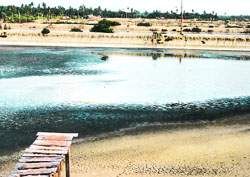
One of the abandoned prawn farms in Puttalam. Pix by M.A. Pushpakumara
Prawn farms struggle to recover losses
By Quintas Perera Prawn farming thrived in the vast span of unused marshy land along the old Dutch canal in the Puttalam district in the mid-1980s. It reached a peak in 1994 and looked promising as a major foreign income earner with big companies such as Carsons and France Aqua maintaining large farms.|
One of the abandoned prawn farms in Puttalam. Pix by M.A. Pushpakumara |
Copyright © 2001 Wijeya Newspapers Ltd. All rights reserved.
Webmaster Editorial